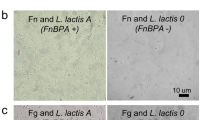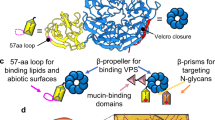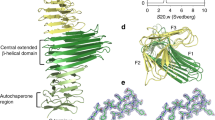Abstract
Staphylococcus aureus and Streptococcus pyogenes, two important human pathogens, target host fibronectin (Fn) in their adhesion to and invasion of host cells1,2. Fibronectin-binding proteins (FnBPs), anchored in the bacterial cell wall, have multiple Fn-binding repeats3 in an unfolded4,5 region of the protein. The bacterium-binding site in the amino-terminal domain (1–5F1) of Fn contains five sequential Fn type 1 (F1) modules. Here we show the structure of a streptococcal (S. dysgalactiae) FnBP peptide (B3)6,7 in complex with the module pair 1F12F1. This identifies 1F1- and 2F1-binding motifs in B3 that form additional antiparallel β-strands on sequential F1 modules—the first example of a tandem β-zipper. Sequence analyses of larger regions of FnBPs from S. pyogenes and S. aureus reveal a repeating pattern of F1-binding motifs that match the pattern of F1 modules in 1–5F1 of Fn. In the process of Fn-mediated invasion of host cells, therefore, the bacterial proteins seem to exploit the modular structure of Fn by forming extended tandem β-zippers. This work is a vital step forward in explaining the full mechanism of the integrin-dependent2,8 FnBP-mediated invasion of host cells.
This is a preview of subscription content, access via your institution
Access options
Subscribe to this journal
Receive 51 print issues and online access
$199.00 per year
only $3.90 per issue
Buy this article
- Purchase on Springer Link
- Instant access to full article PDF
Prices may be subject to local taxes which are calculated during checkout



Similar content being viewed by others
References
Peacock, S. J., Foster, T. J., Cameron, B. J. & Berendt, A. R. Bacterial fibronectin-binding proteins and endothelial cell surface fibronectin mediate adherence of Staphylococcus aureus to resting human endothelial cells. Microbiology 145, 3477–3486 (1999)
Ozeri, V., Rosenshine, I., Mosher, D. F., Fässler, R. & Hanski, E. Roles of integrins and fibronectin in the entry of Streptococcus pyogenes into cells via protein F1. Mol. Microbiol. 30, 625–637 (1998)
Patti, J. M., Allen, B. L., McGavin, M. J. & Höök, M. MSCRAMM-mediated adherence of microorganisms to host tissues. Annu. Rev. Microbiol. 48, 585–617 (1994)
House-Pompeo, K., Xu, Y., Joh, D., Speziale, P. & Höök, M. Conformational changes in the fibronectin binding MSCRAMMs are induced by ligand binding. J. Biol. Chem. 271, 1379–1384 (1996)
Penkett, C. J. et al. Structural and dynamical characterization of a biologically active unfolded fibronectin-binding protein from Staphylococcus aureus. Biochemistry 37, 17054–17067 (1998)
McGavin, M. J. et al. Fibronectin receptors from Streptococcus dysgalactiae and Staphylococcus aureus—involvement of conserved residues in ligand binding. J. Biol. Chem. 268, 23946–23953 (1993)
Joh, D., Speziale, P., Gurusiddappa, S., Manor, J. & Höök, M. Multiple specificities of the staphylococcal and streptococcal fibronectin-binding microbial surface components recognizing adhesive matrix molecules. Eur. J. Biochem. 258, 897–905 (1998)
Sinha, B. et al. Fibronectin-binding protein acts as Staphylococcus aureus invasin via fibronectin bridging to integrin α5β1 . Cell. Microbiol. 1, 101–117 (1999)
Knodler, L. A., Celli, J. & Finlay, B. B. Pathogenic trickery: Deception of host cell processes. Nature Rev. Mol. Cell Biol. 2, 578–588 (2001)
Ing, M. B., Baddour, L. M. & Bayers, S. A. in The Staphylococci in Human Disease (eds Crossley, K. B. & Archer, G. L.) 331–354 (Churchill Livingstone, New York, 1997)
Greene, C. et al. Adhesion properties of mutants of Staphylococcus aureus defective in fibronectin-binding proteins and studies on the expression of fnb genes. Mol. Microbiol. 17, 1143–1152 (1995)
Potts, J. R., Bright, J. R., Bolton, D., Pickford, A. R. & Campbell, I. D. Solution structure of the N-terminal F1 module pair from human fibronectin. Biochemistry 38, 8304–8312 (1999)
Jaffe, J., Natanson-Yaron, S., Caparon, M. G. & Hanski, E. Protein F2, a novel fibronectin-binding protein from Streptococcus pyogenes, possesses two binding domains. Mol. Microbiol. 21, 373–384 (1996)
Penkett, C. J. et al. Identification of residues involved in the interaction of Staphylococcus aureus fibronectin-binding protein with the 4F15F1 module pair of human fibronectin using heteronuclear NMR spectroscopy. Biochemistry 39, 2887–2893 (2000)
Talay, S. R., Valentin-Weigand, P., Jerlstrom, P. G., Timmis, K. N. & Chhatwal, G. S. Fibronectin-binding protein of Streptococcus pyogenes—sequence of the binding domain involved in adherence of streptococci to epithelial cells. Infect. Immun. 60, 3837–3844 (1992)
Signäs, C. et al. Nucleotide sequence of the gene for a fibronectin-binding protein from Staphylococcus aureus—use of this peptide sequence in the synthesis of biologically-active peptides. Proc. Natl Acad. Sci. USA 86, 699–703 (1989)
Schwarz-Linek, U. et al. Binding of a peptide from a Streptococcus dysgalactiae MSCRAMM to the N-terminal F1 module pair of human fibronectin involves both modules. FEBS Lett. 497, 137–140 (2001)
Huff, S., Matsuka, Y. V., McGavin, M. J. & Ingham, K. C. Interaction of N-terminal fragments of fibronectin with synthetic and recombinant D motifs from its binding protein on Staphylococcus aureus studied using fluorescence anisotropy. J. Biol. Chem. 269, 15563–15570 (1994)
Massey, R. C. et al. Fibronectin-binding protein A of Staphylococcus aureus has multiple, substituting, binding regions that mediate adherence to fibronectin and invasion of endothelial cells. Cell. Microbiol. 3, 839–851 (2001)
Talay, S. R. et al. Co-operative binding of human fibronectin to SfbI protein triggers streptococcal invasion into respiratory epithelial cells. Cell. Microbiol. 2, 521–535 (2000)
Derrick, J. P. & Wigley, D. B. Crystal structure of a streptococcal protein-G domain bound to an Fab fragment. Nature 359, 752–754 (1992)
Pickford, A., Smith, S., Staunton, D., Boyd, J. & Campbell, I. The hairpin structure of the 6F11F22F2 fragment from human fibronectin enhances gelatin binding. EMBO J. 20, 1519–1529 (2001)
Cornilescu, G., Delaglio, F. & Bax, A. Protein backbone angle restraints from searching a database for chemical shift and sequence homology. J. Biomol. NMR 13, 289–302 (1999)
Brünger, A. T. X-PLOR (Version 3.1) A System for X-ray Crystallography and NMR (Yale University, New Haven, Connecticut, 1992)
Sass, H. J., Musco, G., Stahl, S. J., Wingfield, P. T. & Grzesiek, S. Solution NMR of proteins within polyacrylamide gels: Diffusional properties and residual alignment by mechanical stress or embedding of oriented purple membranes. J. Biomol. NMR 18, 303–309 (2000)
Ottiger, M., Delaglio, F. & Bax, A. Measurement of J and dipolar couplings from simplified two-dimensional NMR spectra. J. Magn. Reson. 131, 373–378 (1998)
Hashimoto, Y. et al. The relative orientation of the fibronectin 6F11F2 module pair: A N-15 NMR relaxation study. J. Biomol. NMR 17, 203–214 (2000)
Tjandra, N., Garrett, D. S., Gronenborn, A. M., Bax, A. & Clore, G. M. Defining long range order in NMR structure determination from the dependence of heteronuclear relaxation times on rotational diffusion anisotropy. Nature Struct. Biol. 4, 443–449 (1997)
Wishart, D. S., Sykes, B. D. & Richards, F. M. The chemical-shift index—a fast and simple method for the assignment of protein secondary structure through NMR spectroscopy. Biochemistry 31, 1647–1651 (1992)
Talay, S. R., Valentin-Weigand, P., Timmis, K. N. & Chhatwal, G. S. Domain-structure and conserved epitopes of Sfb protein, the fibronectin-binding adhesin of Streptococcus pyogenes. Mol. Microbiol. 13, 531–539 (1994)
Acknowledgements
We thank R. Aplin for mass spectrometry, M. Pitkeathly for peptide synthesis, and S. Lukomski for the S. pyogenes M75 DNA (4673). This research was supported by the Wellcome Trust and the Biotechnology and the Biological Sciences Research Council. J.R.P. acknowledges the British Heart Foundation for financial support.
Author information
Authors and Affiliations
Corresponding author
Ethics declarations
Competing interests
The authors declare that they have no competing financial interests.
Rights and permissions
About this article
Cite this article
Schwarz-Linek, U., Werner, J., Pickford, A. et al. Pathogenic bacteria attach to human fibronectin through a tandem β-zipper. Nature 423, 177–181 (2003). https://doi.org/10.1038/nature01589
Received:
Accepted:
Issue Date:
DOI: https://doi.org/10.1038/nature01589
This article is cited by
-
Microscopy-based phenotypic profiling of infection by Staphylococcus aureus clinical isolates reveals intracellular lifestyle as a prevalent feature
Nature Communications (2022)
-
Discovery of fibrillar adhesins across bacterial species
BMC Genomics (2021)
-
A genomic view of the microbiome of coral reef demosponges
The ISME Journal (2021)
-
Machine learning-driven electronic identifications of single pathogenic bacteria
Scientific Reports (2020)
-
Interaction with the host: the role of fibronectin and extracellular matrix proteins in the adhesion of Gram-negative bacteria
Medical Microbiology and Immunology (2020)
Comments
By submitting a comment you agree to abide by our Terms and Community Guidelines. If you find something abusive or that does not comply with our terms or guidelines please flag it as inappropriate.



